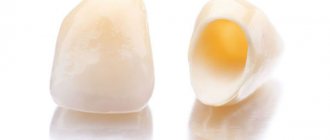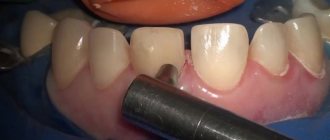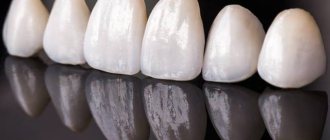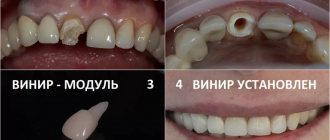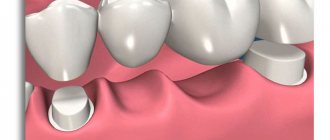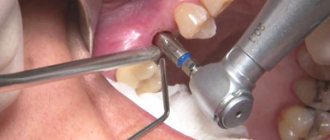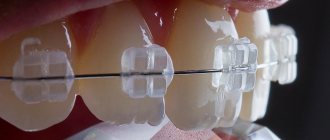E.max Press ceramics can be used to represent various dental objects: veneers, crowns, onlays and inlays. What material the inlays are made from is decided by the dentist himself.
Application area
The scope of application of E.max Press ceramic inlays is extensive. The ceramic inlay is used from conventional prosthetics to the installation of onlays on teeth for their impeccable beauty (Lumineers).
The inlay contains zirconium oxide, which is used to create more durable structures, for example, to restore the anatomical integrity of teeth, and lithium disilicate is used for lighter structures (for example, to restore anterior teeth). It also contains glass ceramics and leucite crystals, which increases the overall strength of the structure.
The E.max ceramic inlay has been used for a long time for the manufacture of this type of structure:
- Veneers and lumineers. Previously, veneers were made from photopolymers, but their short service life forced modern dentists to abandon them. Metal-free veneers are more beautiful and durable.
- Crowns: a classic dental element that has found a new life with E.max. For front teeth, this is the best solution compared to metal-ceramics.
- Inlays: an alternative to photopolymers, which tend to wear out over time. Made under special conditions, ceramic inlays are more durable and less susceptible to abrasion. An exception for E.max is the impossibility of installing long bridges.
An aesthetic smile has always attracted people. Modern dentistry uses every opportunity and means to improve the external characteristics of the dentition.
The appearance of the E.max Press ceramic inlay on the market about 20 years ago exploded the dental market, because it was truly a major breakthrough. Previously, metal-ceramic inserts were used, which were harmful to the patient’s oral cavity.
Types of E-max ceramics –
There are 2 main options for E-max ceramics for the manufacture of veneers and crowns - these are “IPS E-max RPESS” and “IPS E-max CAD”. The indications for their use are very different, as are the technologies for making restorations from these materials, and therefore we will talk about each of them separately.
1) IPS “E-max RPESS” (pressed ceramics) –
E-max RPESS is a glass ceramic designed for injection molding under high temperature and pressure conditions. Pressed ceramics E-max has a very high strength - 400 MPa, which is several times greater than the strength not only of pressed ceramics made from any other materials, but also the strength of E-max CAD.
The excellent aesthetics of the material, together with high strength, make it possible to make from E-max RPESS not only single crowns, but also bridges of up to 3 units inclusive, and even ultra-thin veneers and lumineers. E.max RPESS significantly exceeds the aesthetic capabilities of another type of metal-free ceramic - zirconium dioxide, both due to the greater transparency of the material and due to a greater number of color shade options (Fig. 4-9).
Clinical case No. 1 – before and after photos
Clinical case No. 2 – before and after photos
In addition to the classic material “E-max RPESS”, there is also an improved version called “E-max RPESS Multi”. The second material differs from the first in that it is polychrome (that is, it has a gradient of color and transparency). Why is this, and why is it important... The fact is that in real teeth, the cutting edge and lateral surfaces of the teeth are whiter and more transparent, and in the area of the neck and center of the crown, the tooth is as opaque as possible and usually has a yellowish tint.
The regular E-max RPESS material has one tone and translucency, which is why only “layered” veneers and E-max crowns are made from it. “Layered” means that only the crown frame (cap) is made by pressing, on top of which layers of porcelain mass and dyes are then applied, which give the veneer or crown its final appearance. Using different shades of porcelain mass on the surface of the pressed cap it is possible to create a gradient of color and transparency (24stoma.ru).
Important: E-max RPESS Multi already has a gradient of color and transparency, and therefore it can be used to make monolithic crowns and veneers, which will consist entirely of pressed material (without layers of porcelain mass on the surface). And the final addition of color and shine will be carried out using dyes and the glazing process. As a result, monolithic veneers and crowns made of E-max pressed ceramics will be much more reliable and practically not susceptible to ceramic chips.
E max crowns: patient videos before and after
2) IPS “E-max CAD” (3D milling method) –
E-max CAD are lithium disilicate blocks designed for milling on a computer-controlled machine using CAD/CAM technology. This is a modern method of making crowns and veneers, with virtually no human intervention. The strength of E-max CAD is about 360 MPa, which is slightly less than that of E-max RPESS pressed ceramic. That is why it is recommended to make only single crowns and veneers of standard thickness from this material.
Another disadvantage of E-max CAD is that there are fewer possibilities for selecting shades, which sometimes may not allow achieving an ideal match in color and transparency of crowns with neighboring teeth. By the way, it is CAD/CAM technology that produces crowns and veneers from zirconium dioxide. How the process of milling crowns from E-max CAD occurs – see the video below.
Clinical case No. 3 – before and after photos
Clinical case No. 4 – before and after photos
So which is better - E-max RPESS or E-max CAD?
E-max RPESS material is the best material both in terms of strength characteristics and the ability to achieve ideal aesthetics. In addition, the production of crowns and veneers from E-max RPESS does not require expensive equipment (unlike E-max CAD), which at the same time means a more acceptable cost for patients.
Moreover, the best option would be to use not the usual plain material “E-max RPESS”, but the pre-colored “E-max RPESS Multi”. The blocks of the latter have a gradient of color and transparency, which will allow, without additional staining and application of layers of porcelain mass, to obtain the same gradient of color and transparency from the center of the crown to its cutting edge. In this case, crowns and veneers can be made as monolithic pressed ceramics, i.e. without additional application of porcelain mass to the surface of the pressed crown frame. This will protect you from chipping the ceramics.
Making crowns from E-max CAD: video
Advantages
Experts emphasize the following advantages of the design:
- Extensive experience in using ceramic liners all over the world. More than 30 million restorations have been registered.
- High structural strength. This is due to the fact that when creating liners, a pressing method is used, which guarantees the hardness and uniformity of the material.
- Aesthetics. Crowns and lumineers allow dentists to fine-tune transparency, color, and highlights to achieve maximum naturalness.
- A light weight. The patient quickly gets used to the feeling of something new on the teeth.
- Anti-allergic composition. Allergy sufferers are very lucky. E.max Press has excellent biocompatibility with the human body, so patients do not have to worry about possible allergic reactions.
- Reliability. This design lasts for many years.
Advantages of pressed ceramics
So what are the benefits of these metal-free crowns?
This is what we will try to figure out. Moreover, their very advantage comes from the name.
1. Lightness. Compared to other permanent types of crowns, a metal-free ceramic crown is the lightest. What if there is more than one crown in the mouth? The lower jaw, of course, will not sag from the weight of the metal ceramics, but still... the difference is noticeable.
2. Durability. Thanks to pressing, the strength of the ceramic has greatly increased; now it no longer needs a metal cap as a frame. Imagine two reams of paper, one of which is pressed, which one is stronger than the one that breaks?
3. Color rendition. The color of a tooth covered with a press ceramic crown is deeper and richer. It will definitely be difficult for even an experienced specialist to determine whether it is a real tooth or an artificial crown, not to mention the people around you. In short, it is better to see once than to hear constantly. The color is so rich that words cannot describe it.
4. Metal-free crowns price. Yes, and I didn’t make a mistake. Please do not compare with metal-ceramic crowns, these are completely different weight categories. But when compared in the metal-free category, in particular with zirconium dioxide, press ceramics will come out the winner.
Also read: Metal-free ceramics: photos of prostheses
5. Non-invasive. To process a tooth under a ceramic press, it is necessary to grind less hard tooth tissue than for other permanent structures. The explanation is quite simple - the thickness of the crown, which we will put on the ground tooth. The more of our own hard tooth tissues we preserve, the longer it will last.
6. Versatility. Not only new crowns are made from press ceramics, but also inlays, onlays for teeth and attention - ceramic veneers .
7. Vitality. Thanks to the gentle treatment of the hard tissues of the tooth, there is no rule for depulping it. The tooth can be left alive, with the correct protocol for its preparation in order to avoid overheating of the pulp, and therefore, a living tooth will last much longer than a dead one.
8. Manufacturing. Easier and faster than other types of crowns.
And these are not all the advantages...
Among the negative aspects, it is necessary to note the impossibility of manufacturing long-term bridges and in the lateral section.
Indications for use
E.max Press shown:
- for creating ceramic crowns;
- for restoration of tooth enamel and teeth;
- for installation of implants;
- to eliminate dental defects (gaps between teeth);
The design also has contraindications:
- Parafunctions of the jaw (bruxism); presence of bad habits (biting nails, opening various objects with teeth, etc.);
- fluorosis (excess fluoride, which results in yellowing of the teeth);
- any other orthopedic structures in the oral cavity (they block the installation of e.max ceramics (bracket system, retainer)).
Indications and contraindications for the installation of press ceramic veneers
Veneers (not only ceramic) are most often installed on the front teeth, which are visible when smiling, and modern materials allow installation even on second premolars. In practice, this is the only way to restore severely damaged teeth in a short time. This type of microprosthetics is suitable for both healthy and pulpless teeth in order to eliminate external dental problems associated with imperfect shape or color of enamel.
Most often, plates made of pressed ceramic material are used in the following cases:
- defects of tooth enamel or dentin;
- change in enamel color due to caries;
- chips or cracks;
- large interdental spaces (diastemas, trema);
- systemic or focal demineralization;
- tooth curvature (most often slight);
- discoloration of fillings or tooth enamel as a result of treatment with various antibiotics.
Also, there are contraindications to this method of prosthetics, as with any other type of treatment. Orthopedic dentists do not recommend placing ceramic plates for the following indications:
- carious lesions of enamel and periodontal disease;
- severely damaged teeth or too large fillings installed on them, due to which there will be a loss of hardness of the tooth surface, which will lead to its destruction in the case of an onlay;
- with involuntary clenching and grinding of teeth (bruxism).
These contraindications apply not only to ceramic veneers; any microprostheses of this kind should be installed only on treated teeth. Therefore, at an appointment with an orthopedist, a thorough medical history is collected to draw up a more correct treatment plan, and therefore, the patient may require the services of a dental therapist or hygienist.
Planning and installation steps for E.max
To avoid unexpected adverse consequences, before installing the E.max tab, an accurate diagnosis is carried out and the presence of all kinds of contraindications is identified. Clinicians may use a facebow, articulators, or wax-up/computer sculpting for structures that are temporary. In severe cases, patients are prescribed axiography.
Experts distinguish several successive phases of prosthetics:
- First, a cast of the jaw that needs restoration is made. After this, a tooth of the desired shape is modeled using wax on this model. The external appearance of the source copy reproduces the natural version as accurately as possible.
- The doctor, based on tests, examination and examination of the oral cavity, determines which design is required in a particular case (crown, veneer, or solid tooth). The material is placed in a specially designed oven, where a ceramic blank is added.
- After completing the process of preparing the blank, the dental technician adjusts the model for the patient.
- Dental glaze is applied to the finished structure so that the teeth take on the natural color of the enamel. This process will be carried out in the dental office so that the doctor can assess the condition of the workpiece.
- The end of the procedure is the creation of reliable fastenings to the structure. If necessary, correction can be made.
- Securing the finished denture in your mouth.
The developers of E.max Press approached the fixation process with all responsibility. There are traditional, adhesive and self-adhesive fastening methods. There is also a huge selection of dental composite adhesives to choose the best option for each patient individually.
Manufacturing technology and installation
The production of a ceramic microprosthesis begins with taking impressions. The resulting models are sent to the laboratory along with X-rays of the patient’s jaw. The task of the dental technician will be to create an orthopedic structure. This is possible using two technologies: computer modeling CAD/CAM and hot pressing with layer-by-layer application.
Fixation of metal-free ceramics is carried out using a primer or cement, which is illuminated with a special lamp. Only an experienced dentist can place a microprosthesis correctly. If mistakes were made during this process, there is a possibility of inflammatory diseases of the oral cavity and loss of the structure.
Stages of manufacturing all-ceramic crowns:
- Obtaining a collapsible model.
- Crown modeling.
- Her pressing.
- Applying facing material to the structure frame.
- Final processing.
- Glazing.
Pressed ceramic crowns (press ceramic) can be made by surface staining and layering. The first option is considered for prosthetics of chewing teeth. The layering method involves applying ceramic mass layer by layer. This method is suitable when high aesthetics are important.
An important stage of prosthetics is preparation. The patient is required to undergo a visual examination, x-rays, and root canal treatment.
Grinding of teeth is required, but the doctor removes much less tissue than for installing metal crowns. But removing the nerve is not a necessary measure, and if the tooth is healthy, then it is preserved.
Possible complications
E.max ceramics are an absolutely gentle material, which in rare cases can cause some problems. Complications may include:
- Color discrepancy (if the manufacturing process was disrupted);
- Noticeable edge fit (indirect effect, when the structure can be easily distinguished from natural enamel by a noticeable colored rim);
- Irregular tooth shape (most often found on the front of the incisors);
- inflammation of the gums or inner layers of the tooth.
To avoid these problems, the specialist who installed the structure should consult with the patient’s attending dentist.
Press ceramics - reviews
Pressed ceramics in dentistry e max is a structural material for the ideal solution to dental problems. The high tensile strength and optical characteristics illustrate the wide possibilities of this type of prosthetics.
The topic of e.max restoration is of interest to an increasing number of patients - and this is quite reasonable, since veneers, inlays, and lumineers made on the basis of metal-free ceramics are superior in all respects to materials known in dentistry.
Pressed ceramics logically require higher prices than classic metal-ceramic structures, but this does not discourage patients seeking dental restoration at the level of high European standards. Like natural teeth, press ceramics require constant care at home, but it is advisable to visit a doctor once a year for a preventive examination and use professional hygiene products on the advice of a specialist.
Reviews on dental forums in thematic sections - press ceramics, e.max - are invariably positive due to the excellent optical and physical properties.
Often patients, undecided on their choice, pay attention to the opinions of those who have already experienced the process of dental prosthetics, and are also interested in the point of view of experienced specialists.
It should be noted that e max ceramics has achieved success and recognition, securing high performance in practice, but the indications for its use are individual, so it is especially important to clarify in advance all the nuances of prosthetics, the price scale, indications and contraindications, and then make a decision taking into account medical advice.
Installation time for a metal-free crown e.max
As a rule, the process of production and fixation of such a prosthesis covers a period of 14 days, depending on each individual case. In case of complete absence of a tooth, it may be necessary to use implantation systems. In such situations, you should wait until the osseointegration of the implant is completed, which usually takes 12-18 weeks (4-5 weeks when installing Straumann implants).
To compensate for the aesthetic deficiency associated with a missing tooth, the patient is given a temporary plastic structure. Installation of a permanent prosthesis is carried out after the healing process is complete.
What complications may there be?
Each organism is individual, and therefore it is difficult to predict its reaction to certain dental procedures. Even if you contact a highly qualified specialist, complications may arise after installing crowns. The most common problems are the following.
- The crown rubs the gums, causing discomfort and pain. In this case, you should contact the specialist who performed the procedure; he will be able to fix the problem by making a new prosthesis or adjusting the existing one.
- The prosthesis looks unnatural in color. In this case, the problem will also be quickly resolved by the orthopedist who carried out the prosthetic work. It will be necessary to choose a different color and make a new prosthesis.
- Aching or sharp pain under the installed prosthesis. This can happen if the nerve, for example, is not completely removed on the turned unit, or if an inflammatory process has begun under the crown due to a number of reasons. The patient’s actions are to immediately contact an orthopedic dentist for consultation and treatment. In such situations, you will need to remove the prosthesis, clean the canals/carry out other necessary dental procedures, put a filling and reinstall the crown.
- The appearance of bad breath. It can cause inflammation under the crown or improper oral hygiene.
Attention! A visit to a trusted dental clinic and an experienced orthopedic surgeon will help you avoid many negative consequences.
How long will a ceramic crown last?
The service life of ceramic crowns installed in Zen dentistry is practically unlimited. The crowns themselves perfectly withstand even high loads when chewing food. Any chips that occur can be easily restored by polishing. The absence of an opaque metal frame makes any damage to the surface of an all-ceramic crown almost invisible.
It is not so much the crown that wears out during use, but the cement on which it is attached to the tooth. Over time, this cement becomes more and more porous due to saliva that somehow gets under the crown, its adhesive properties are lost, and bacteria and microbes begin to penetrate under the crown. If the crown is not replaced on time, the abutment tooth will begin to decay. Therefore, one should not neglect free preventive examinations at the dentist, to which patients of Dzen Dentistry are invited every six months.
Ceramic crowns for front teeth
Many experts believe that ceramic dental crowns can only be used for prosthetics of the front teeth. Meanwhile, new generation pressed ceramics make it possible to make not only highly aesthetic, but also highly durable structures. The absence of a metal frame in such prostheses is not a sign of fragility or unreliability. Ceramic crowns for chewing teeth also have a place in dental practice.
When is it better to install e.max crowns and when to install zirconium crowns?
Thus, e.max crowns, as evidenced by reviews from patients and doctors, are considered the optimal design in the following situations:
- If it is necessary to restore single teeth;
- If there is a need to recreate several lost units in the frontal zone (fixation of bridges);
- If the patient has excessive demands on the aesthetic performance of prostheses;
- If the enamel has increased light transmittance.
In turn, zirconium material will be more preferable if the following indications are present:
- If necessary, the manufacture of bridge structures for the chewing teeth area;
- If there is a need to create bridges of significant length;
- If you need to make dentures using dental implants as supports;
- If the patient suffers from bruxism.
Read more about zirconium dioxide crowns »
Types of ceramic structures
- Classic dentures. Dental technicians make such crowns from solid ceramics. They have a beautiful appearance, as close to natural as possible, and an affordable price, but at the same time they are somewhat fragile when compared with other types of prosthetics.
- Pressed ceramic crowns. Modern orthopedic dentistry offers:
- E-max design (contains lithium disilicate). In terms of their strength, these types are not inferior to metal-ceramics and are suitable for installation not only on dental units in the smile area, but also on chewing ones. One of the most popular prosthetic options.
All-ceramic E-max system
For comparison, press ceramic teeth (E-max design) and metal-ceramic crowns
- E-mpress designs. This type of prosthesis is made from the same material as E-max, but it also contains special crystals of the mineral leucite. This type will be somewhat stronger than solid ceramics, but more delicate than E-max, and therefore is not suitable for use on teeth that bear the main chewing load.
Benefits of Using a Digital Impression
To prevent possible errors and undesirable results when taking the impressions required for the production of e.max crowns, and to ensure an exact fit to the shape of the ceramic structure, the innovative 3shape scanning method is used.
The e.max ceramic crowns obtained through the use of this technology, as evidenced by reviews, are distinguished by perfect aesthetics and impeccable functional characteristics.
The Implantmaster clinic uses an ultra-modern 3Shape trios scanner, with which it is possible to create high-quality crowns and also provide patients with the necessary orthopedic services.
3shape Trios scanner - instead of casts »
Kinds
Under the IPS E-max brand, owned by the international company Ivoclar Vivadent AG, several types of blanks are produced that can be used in accordance with the specific clinical picture and the dentist’s recommendations. These include:
- Press is a standard modification used in most cases;
- ZirPress – special facing composition;
- CAD – glass-ceramic blocks-blanks;
- ZirCAD – compositions supplemented with zirconium dioxide;
- Ceram is a composite material for the outer layer.
It is worth noting that the models presented in the line are distinguished by high levels of durability and visual aesthetics. Thanks to them, dental restoration has reached a new level, allowing you to create the perfect smile without wasting extra time.
Main differences from metal ceramics
When choosing between a metal crown and metal-free ceramics, you should consider the main differences between these two prosthetic options. They need to be assessed based on strength, biocompatibility and aesthetics.
Differences between metal-free microprostheses and metal-ceramic ones:
- They do not have a metal frame, due to which they imitate the color and structure of natural teeth, therefore they are used to solve both functional and aesthetic problems.
- They do not lead to inflammation of the gums, as they are attached as precisely as possible. The absence of metal is also important here, which eliminates oxidation.
- They are thinner, which means they require less grinding of the enamel, which helps preserve teeth for a long time.
An alternative to a crown is an inlay. This option is considered in case of minor tooth decay, when it can still be saved. The inlay is a kind of filling, which is many times stronger and more natural in appearance than a regular one.
